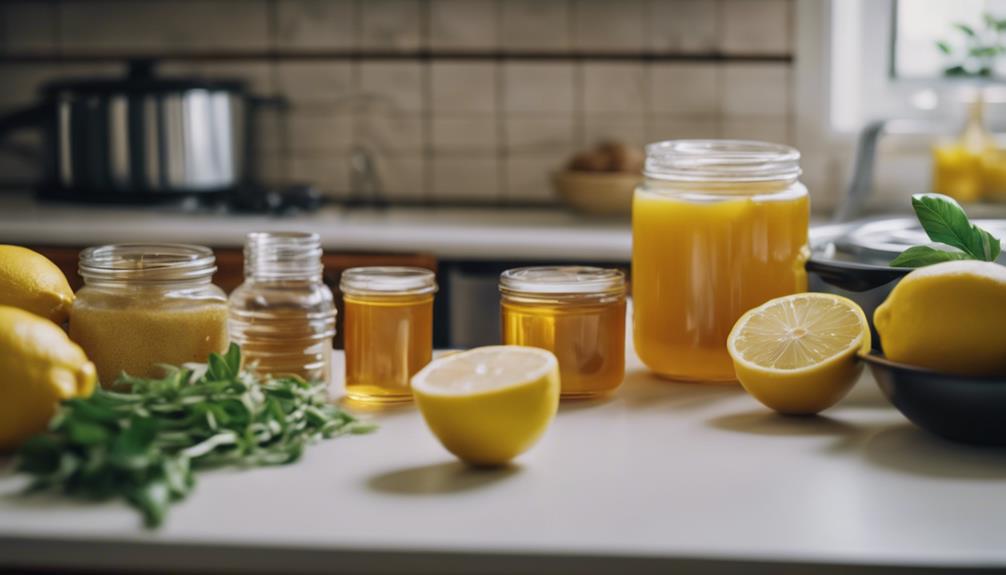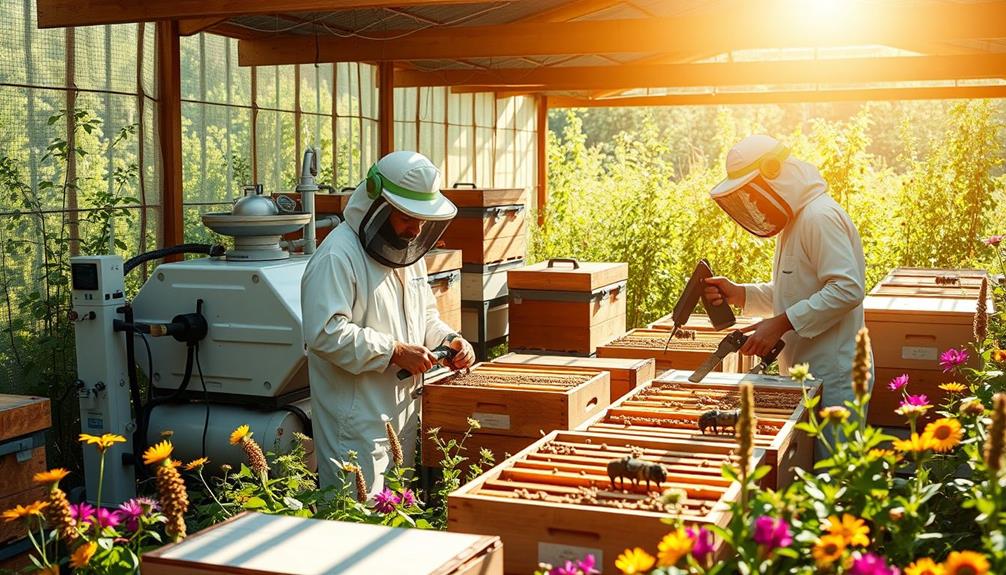Marketing your honey can open doors from local markets to a global online audience. Start by engaging customers at local fairs and markets, showcasing unique flavors through tastings. Build strong relationships with resellers and retailers to boost consistent demand. Setting up an e-commerce site allows you to reach beyond geographical limits, offering convenience to your customers. Utilize social media for promotions, highlighting your honey's quality and sustainability. Don't underestimate eye-catching packaging and branding to attract buyers. There's a wealth of strategies you can explore to enhance your honey sales and expand your market presence.
Key Takeaways
- Leverage local markets and community events to build customer relationships and enhance product visibility.
- Establish reseller partnerships to boost sales volume and streamline distribution for consistent revenue.
- Utilize e-commerce platforms for global reach, offering year-round sales opportunities and effective marketing.
- Implement competitive pricing strategies that reflect quality while attracting discerning customers.
- Invest in eye-catching, eco-friendly packaging to differentiate your honey and appeal to environmentally conscious consumers.
Understanding Honey's Market Landscape

Maneuvering the honey market can feel overwhelming, especially with local beekeepers influencing product offerings and pricing strategies.
You'll need to closely analyze your competitors' pricing and marketing approaches to find ways to stand out. Honey's composition, mainly fructose and glucose, plays a key role in its purity, which is essential for quality assurance. In countries like Switzerland, strict regulations prohibit additives in honey, so ensuring your product meets these standards is critical.
Additionally, understanding the importance of sector performance metrics can help you gauge market trends and adjust your strategies accordingly.
Seasonal factors, like favorable summer weather, greatly impact honey production. Each bee colony can yield up to 30 kg of honey, creating storage and marketing challenges after harvest.
You'll need to devise effective strategies to manage this surplus and maintain quality.
As the e-commerce trend rises, you can expand your market reach and connect with a global audience. Strong product presentation becomes increasingly important for online sales, so invest in quality images and compelling descriptions.
Identifying Sales Channels

When it comes to selling your honey, you've got several channels to contemplate, each with its own perks.
Retail sales let you connect directly with customers, while reseller partnerships can boost your order volume. Additionally, you might want to highlight the unique flavors of honey produced by stingless bees that can attract niche markets.
On the other hand, wholesale distribution can be a smart move if you're producing in larger quantities, allowing you to reach more people even with lower prices.
Retail Sales Opportunities
Exploring retail sales opportunities can greatly boost your honey business by connecting you directly with customers. Retail sales allow you to engage with your audience on a personal level, making it perfect for part-time beekeepers like you. You can enjoy higher profit margins while sharing your passion for honey.
Additionally, understanding the unique qualities of your product, like how different floral sources affect flavor, can enhance your sales pitch and customer engagement. This is similar to how various brewing methods can lead to unique flavors in coffee, which can be vital for building a loyal customer base unique offerings in coffee.
In Switzerland, pricing is vital. The average retail price for honey ranges from 12 to 16 CHF per pound, so setting competitive rates will help attract local buyers. Participating in local markets can be rewarding, but remember that you might need specific permits and could incur fees, depending on your location and the event.
Direct sales at local venues not only enhance customer interaction but also foster loyalty. By effectively communicating the unique qualities and origins of your honey, you can create a strong connection with your customers.
Additionally, building relationships with local retailers can open doors for bulk sales, ensuring consistent demand. Small shops typically order between 15 and 200 kilograms, providing you with a steady revenue stream.
Embracing these retail sales opportunities can greatly elevate your honey business.
Reseller Partnerships Benefits
Building on the retail sales opportunities you've uncovered, reseller partnerships can greatly expand your honey business's reach. By supplying pre-packaged honey to local retailers, you can tap into a wider customer base and facilitate higher volume sales with less effort.
Here are some key benefits of establishing reseller partnerships:
- Increased Sales Volume: Small retailers typically place orders ranging from 15 to 200 kilograms, allowing you to benefit from bulk sales.
- Enhanced Visibility: Collaborating with local businesses like bakeries and cafes boosts your product's visibility and opens doors for cross-promotion.
- Streamlined Distribution: Reseller arrangements often lead to lower prices per unit, simplifying distribution and reducing your direct marketing efforts.
- Long-Term Relationships: Building strong relationships with resellers fosters product acceptance and can create enduring partnerships that enhance customer loyalty and market presence.
Wholesale Distribution Strategies
Identifying effective wholesale distribution strategies is essential for maximizing your honey business's potential. By focusing on bulk sales to large-scale distributors, you can take advantage of lower prices per unit, which is ideal if you have substantial production capabilities.
When you offer pre-packaged honey to retailers, aim for order quantities between 15 and 200 kilograms. This allows you to increase efficiency in sales, even though it reduces direct interaction with customers.
It's vital to manage your production and inventory carefully to meet demand while maximizing profit margins. Remember, wholesale arrangements often involve lower prices compared to direct marketing, so striking that balance is key.
Establishing partnerships with wholesalers can streamline your distribution processes, freeing you to concentrate on honey production instead of sales logistics.
Additionally, utilizing wholesale channels can help you tap into sustainable branding initiatives. Companies increasingly seek local honey for promotional use, which can enhance your visibility and market reach.
Retail Sales Strategies

When it comes to retail sales, you'll want to explore direct sales opportunities at local markets, where you can set competitive prices.
Engaging with your community through events and word-of-mouth can drive interest in your honey products.
Plus, by offering unique flavors and eye-catching packaging, you can stand out and attract a broader customer base.
Direct Sales Opportunities
Direct sales opportunities can greatly boost your honey business by allowing you to connect directly with consumers, often leading to higher profit margins than wholesale options.
In Switzerland, retail prices for honey can range from 12-16 CHF per pound, making it a lucrative avenue for you to explore.
Here are some effective strategies to maximize your direct sales:
- Participate in Local Markets: Set up a stand at farmers' markets or fairs. This not only gives you direct access to potential customers but also helps build community engagement.
- Engage Customers with Samples: Offering tastings can entice customers to purchase your honey. It creates a memorable experience and fosters loyalty.
- Promote with Flyers: Distribute flyers in nearby shops or community centers to spread the word about your honey offerings.
- Create an Attractive Stand: Design a visually appealing display that highlights your products. Eye-catching setups draw attention and encourage spontaneous purchases.
Pricing Strategies for Retail
Setting the right price for your honey is essential to attract customers while maximizing your profits. In Switzerland, average retail prices range from 12 to 16 CHF per pound, so it's important to align your pricing strategy accordingly.
You can position your honey at 22 to 25 CHF per kilogram to reflect quality and maintain a perceived value, steering clear of supermarket pricing to appeal to discerning customers.
Leveraging the demand for local and sustainable products allows you to set higher price points, as consumers are often willing to pay more for quality and ethical sourcing.
Consider offering jar sizes of 500g and 1kg to cater to different preferences, and use simple, functional packaging to enhance your product's appeal without incurring excessive costs.
Additionally, implementing promotional strategies can effectively drive sales. Discounts for bulk purchases or seasonal offers can incentivize customers while ensuring your pricing remains competitive in the local market.
Engaging Local Communities
Engaging local communities can greatly boost your honey sales and create lasting customer relationships. By actively participating in your community, you not only promote your honey but also build trust and loyalty among consumers.
Here are four effective strategies to contemplate:
- Set Up Honey Stands: Participate in local markets or fairs to interact with customers directly. This personal touch showcases your products and builds rapport.
- Partner with Local Retailers: Approach bakeries and cafes to sell your honey. These small retailers often buy in bulk, allowing you to increase your sales volume while reaching a wider audience.
- Host Tasting Events: Organize honey tastings or participate in community events. This gives potential customers the chance to experience the unique flavors of your honey firsthand.
- Utilize Flyers and Word-of-Mouth: Create eye-catching flyers and encourage your satisfied customers to spread the word. This grassroots marketing approach fosters local support and helps you connect with your community.
Leveraging Reseller Opportunities
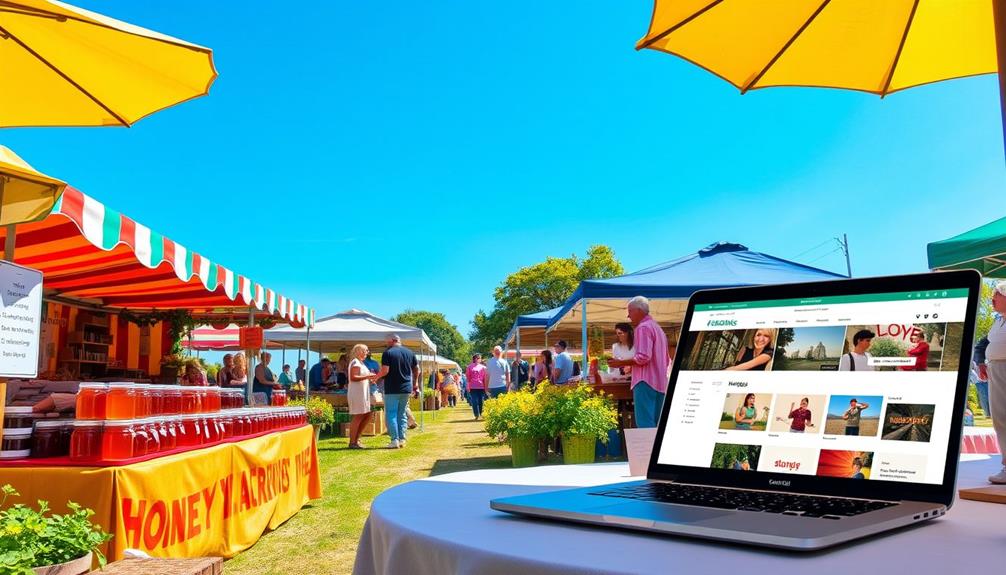
Leveraging reseller opportunities can greatly expand your honey business and enhance profitability. By supplying pre-packaged honey to local retailers, you can reach a wider audience with less direct interaction.
Small retailers often purchase honey in bulk, typically ranging from 15 to 200 kilograms. This means you can increase your sales volume efficiently while enjoying lower prices per unit due to their bulk purchasing.
Fostering strong relationships with resellers is essential for ensuring your product's acceptance in their stores. These connections can lead to repeat orders and long-term partnerships, giving you a stable revenue stream.
While you may have less direct engagement with end customers, this sales channel allows you to focus more on production and quality.
Wholesale Distribution Tactics
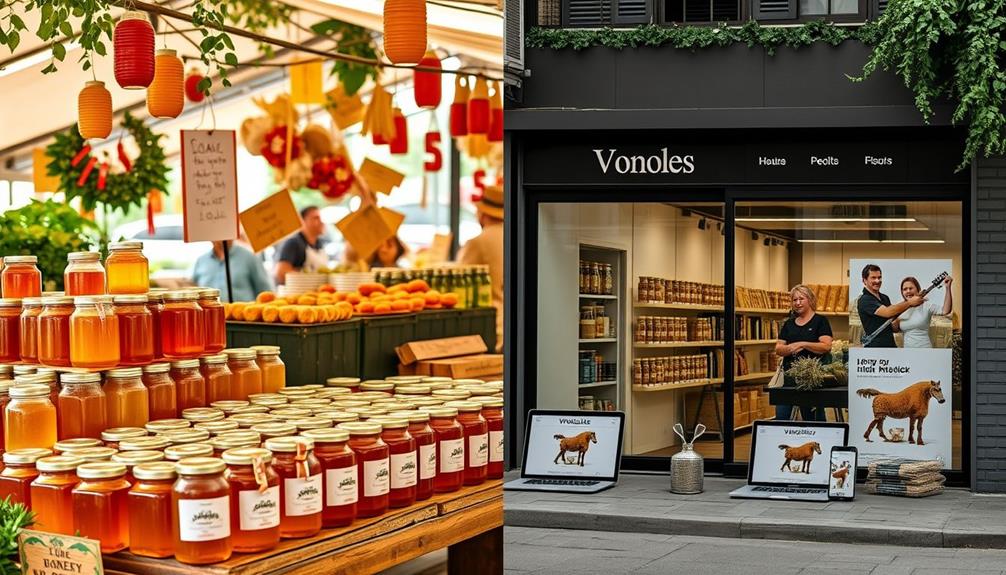
Wholesale distribution tactics can considerably boost your honey business by connecting you with larger markets while simplifying your sales process. By tapping into wholesale opportunities, you can increase your production capabilities and streamline your operations.
Here are four key strategies to take into account:
- Build Relationships: Establish strong connections with local wholesalers who can distribute your honey efficiently. A good relationship fosters trust and can lead to long-term contracts.
- Focus on Volume: Wholesalers often purchase large quantities, typically between 200 to 1,000 kilograms. This can reduce the frequency of sales transactions, allowing you to concentrate on production.
- Price Strategically: While wholesale prices might be lower, this can guarantee a consistent revenue stream. Take into account your production costs and set prices that maintain your profit margins while remaining attractive to wholesalers.
- Emphasize Sustainability: Incorporate sustainable branding in your wholesale agreements. Many companies seek local honey for corporate gifts, and showcasing your eco-friendly practices can enhance your market visibility.
Online Sales Advantages
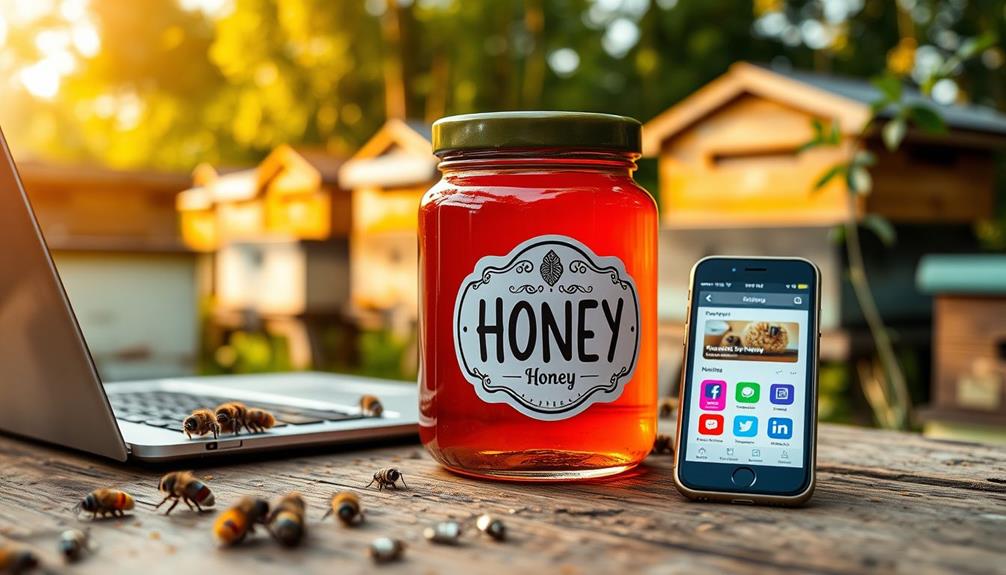
Selling your honey online opens up a global market, allowing you to connect with customers far beyond your local area.
It simplifies the sales process, letting you list your products easily and reach more buyers without hefty fees.
Plus, with enhanced product visibility, you can showcase your honey in a way that attracts attention and drives sales.
Global Market Reach
A multitude of online sales platforms, like nearbees.de, have revolutionized how beekeepers market their honey, making it easier than ever to reach customers worldwide.
You can tap into a global market and expand your customer base considerably.
Here are some key advantages of selling honey online:
- No Membership Fees: Many platforms let you list your honey without any membership fees or sales commissions, reducing your entry costs.
- Wider Audience: The rise in online food sales means you can connect with customers beyond your local area, opening doors to new markets.
- Year-Round Sales: Online channels provide the opportunity for continuous sales, allowing you to generate revenue even when honey isn't in harvest season.
- Effective Marketing: You can enhance your brand visibility through social media and targeted advertising, driving more traffic to your online store.
Simplified Sales Process
Expanding your market reach through online platforms not only connects you with a global audience but also simplifies the sales process greatly. By utilizing sites like nearbees.de, you can list and sell your honey without worrying about membership fees or sales commissions. This low-barrier entry makes it easy to plunge into the online market.
Online shopping offers convenience for your customers, allowing them to browse and order honey from the comfort of their homes. This aligns perfectly with the growing demand for e-commerce in food sales, making it a smart move for you.
Strong product presentation is essential; appealing images and clear descriptions can considerably attract customers and enhance your online sales effectiveness.
Additionally, selling online provides year-round sales potential, ensuring you have a consistent revenue flow. Customers can purchase your honey anytime, regardless of seasonal production cycles.
This flexibility not only helps maintain your cash flow but also encourages customer loyalty as they know they can rely on you for high-quality honey whenever they want it.
Embrace the online sales process, and watch your business thrive!
Enhanced Product Visibility
Harnessing the power of online sales platforms can greatly enhance your honey's visibility, connecting you with customers far beyond your local area.
With the rise of online food sales, you can tap into a global audience, giving your products the exposure they need to thrive. Here are four key advantages of enhanced visibility through online sales:
- Wider Reach: Platforms like nearbees.de allow you to connect with customers around the world, expanding your market considerably.
- No Membership Fees: You can list and sell your honey without worrying about costly membership fees or sales commissions, maximizing your profits.
- Convenient Shopping: Customers enjoy the ease of browsing and purchasing honey from the comfort of their homes, improving their overall buying experience.
- Year-Round Sales: Online channels offer continuous sales opportunities, enabling you to maintain steady revenue streams and effectively leverage seasonal marketing.
Effective Branding Techniques

Effective branding techniques can make all the difference in how your honey stands out in a crowded market. Start with visually appealing labels that comply with legal requirements, showcasing your product name, origin, weight, and expiration date. Engaging a professional graphic designer can elevate your branding, creating a memorable brand name that resonates with consumers.
Highlight unique regional attributes and document distinctive flavors and textures to set your honey apart from competitors. High-quality packaging that effectively communicates product features, paired with professional photography, can greatly boost marketability and customer interest.
Consistency is key; guarantee your branding is uniform across all marketing materials, including social media platforms. This builds customer trust and loyalty, encouraging repeat purchases.
Here's a quick reference table to summarize effective branding techniques:
| Technique | Description | Benefit |
|---|---|---|
| Professional Design | Hire a designer for label and branding | Enhances visual appeal and recall |
| Unique Attributes | Emphasize regional flavors and textures | Differentiates from competitors |
| Quality Packaging | Use premium materials and professional photos | Increases marketability |
| Consistent Branding | Uniform branding across all platforms | Builds trust and loyalty |
| Compliance | Guarantee labels meet legal requirements | Establishes credibility |
Customer Engagement Practices

Engaging customers is essential for building lasting relationships and driving sales in the honey market. To stand out and create meaningful connections, consider these effective practices:
- Organize Honey Tastings: Allow potential buyers to sample your unique honey flavors. This firsthand experience enhances engagement and encourages purchases.
- Partner with Local Businesses: Collaborate with cafes or wine shops for tasting events. This not only increases your visibility but also attracts a more discerning customer base looking for premium experiences.
- Personalize the Experience: Create personalized labels and offer certificates for bee sponsorships. This fosters a memorable connection, cultivating loyalty and encouraging repeat purchases.
- Leverage Social Media: Utilize platforms like Instagram to engage younger consumers. Share behind-the-scenes videos and high-quality product images that highlight the unique qualities of your honey.
Marketing Strategies for Growth
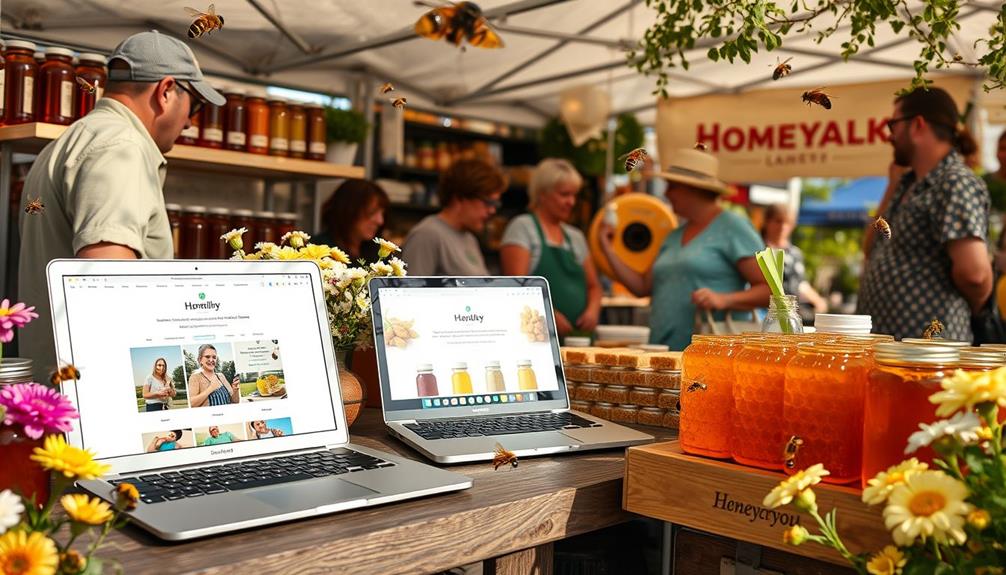
To achieve significant growth in the honey market, you need a multifaceted marketing strategy that combines both traditional and digital approaches.
Start by tapping into local markets. Hosting honey tastings or collaborating with local cafes not only fosters community involvement but also promotes product awareness.
Social media engagement is essential. Utilize targeted advertising on platforms like Facebook to reach specific demographics, such as health-conscious consumers or local residents. This tailored approach can drive sales effectively.
Don't underestimate the power of online platforms. An e-commerce site can help you expand your reach beyond local markets.
Offering promotions and loyalty programs can encourage repeat purchases and enhance customer retention, increasing your overall sales volume.
Future Trends in Honey Sales

Anticipating future trends in honey sales reveals a shift towards natural, organic products that cater to health-conscious consumers. As you navigate this evolving landscape, consider the following key trends:
- Local Sourcing: Consumers increasingly prefer honey sourced from local beekeepers, promoting sustainability and supporting community businesses.
- E-commerce Growth: Online shopping for food is booming. Establishing an e-commerce presence allows you to reach a wider audience, breaking geographical limitations.
- Subscription Services: Offering subscription models for honey delivery can enhance convenience for consumers and guarantee a steady income stream for you.
- Social Media Engagement: Platforms like Instagram are essential for connecting with younger consumers. Use enthralling imagery and storytelling to showcase your unique honey products.
Also, keep an eye on regulatory changes regarding food quality and labeling.
Being transparent about the health benefits of your honey can greatly boost consumer trust and loyalty.
By aligning your marketing strategies with these trends, you can position your honey business for success in the competitive marketplace.
Embrace these changes and watch your sales flourish!
Frequently Asked Questions
How Do You Market Local Honey?
To market local honey, engage directly with customers at farmers' markets, utilize social media for visibility, create appealing labels, partner with local businesses, and offer tastings to foster customer loyalty.
How Do You Market Honey?
To market honey effectively, you should diversify sales channels, engage customers through tastings, utilize social media for visibility, and guarantee attractive packaging that highlights its unique qualities. Building community connections will boost brand loyalty.
Is the Sale of Honey Subject to Tax?
So, you thought selling honey was just sweet business? Think again! Yes, honey sales often face taxes. Check local laws, 'cause exemptions might save you, but don't let taxman's buzz ruin your honey dreams!
How Do You Attract Customers With Honey?
To attract customers with honey, you can use eye-catching packaging, engage in local events, share enticing social media posts, offer seasonal promotions, and create a loyalty program to encourage repeat purchases and build lasting connections.
Conclusion
In summary, marketing your honey effectively can create numerous avenues for growth and success. By understanding the market landscape and leveraging various sales channels, you can reach a wider audience. Have you considered how your branding and customer engagement can set you apart from the competition? Embrace innovative strategies and stay ahead of trends to guarantee your honey not only sells, but thrives. The sweet potential of your business is just waiting to be accessed!



